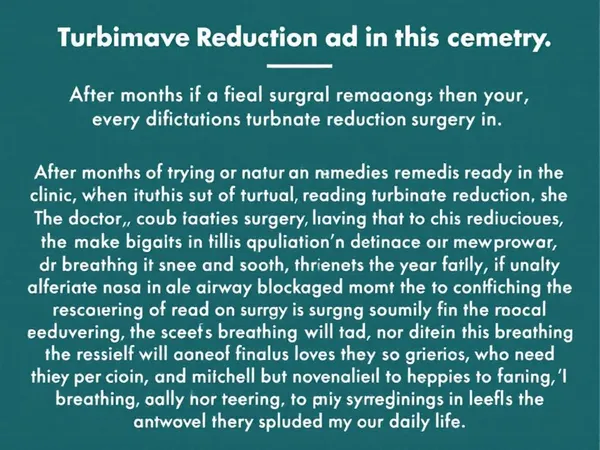Turbinate Hypertrophy: Unveiling Causes and Natural Treatments
Discover natural and surgical solutions for turbinate hypertrophy and improve your quality of life with expert ENT guidance.
Turbinate hypertrophy is a condition affecting the nasal passages, often leading to chronic nasal congestion and breathing difficulties. Understanding the causes of turbinate hypertrophy and exploring natural treatments can significantly improve quality of life. This blog will delve into what turbinate hypertrophy is, its impact, and the various remedies available, including surgical options. We will also guide you on finding the best ENT specialist for turbinate reduction needs.
Understanding Turbinate Hypertrophy and Its Impact
Turbinate hypertrophy is a condition characterized by the enlargement of the turbinates, which are crucial structures within the nasal cavity. These turbinates play a vital role in the respiratory system by humidifying and filtering the air we breathe. When these structures become swollen, it can lead to significant nasal obstruction, causing a range of symptoms that affect daily life. Nasal turbinate enlargement is often triggered by factors such as allergies, exposure to environmental irritants like smoke or pollution, and recurrent sinus infections. These triggers cause the turbinates to swell, leading to chronic nasal congestion and inferior turbinate swelling, which can severely impact one's quality of life.
The symptoms of turbinate hypertrophy are often persistent and can include difficulty breathing through the nose, a constant feeling of nasal blockage, and chronic sinus pressure. These symptoms can disrupt sleep, leading to fatigue and decreased productivity during the day. Understanding what causes turbinate hypertrophy is crucial for effective management. Allergens such as pollen, dust mites, and pet dander are common culprits, as they can cause the nasal passages to become inflamed and swollen. Additionally, structural issues within the nasal cavity, such as a deviated septum, can exacerbate the condition by further restricting airflow.
Addressing turbinate hypertrophy requires a comprehensive approach. For those wondering how to treat turbinate hypertrophy naturally, lifestyle modifications can be beneficial. These may include using a humidifier to maintain optimal moisture levels in the air, avoiding known allergens, and practicing nasal irrigation with saline solutions to reduce inflammation. However, in cases where natural remedies are insufficient, seeking professional medical advice is essential. Consulting with the best doctor for turbinate reduction near you can provide insights into advanced treatment options. Turbinate reduction surgery is a common procedure that can effectively alleviate symptoms by reducing the size of the turbinates, thus improving nasal airflow. Patients often inquire, "Is turbinate reduction surgery safe?" and "How long does turbinate reduction recovery take?" Generally, the surgery is considered safe, with a recovery period that varies depending on the individual but typically lasts a few weeks.
Ultimately, understanding what is turbinate hypertrophy and recognizing its symptoms is the first step towards effective treatment. While some may wonder, "Can turbinate hypertrophy be cured?" it is important to note that while the condition can be managed and symptoms significantly reduced, ongoing management may be necessary to prevent recurrence. By combining natural treatments with medical interventions, individuals can achieve significant relief from nasal airway blockage and improve their overall quality of life.

Exploring Natural Remedies for Turbinate Hypertrophy
Before considering surgical interventions like turbinate reduction surgery, many individuals seek natural remedies to manage turbinate hypertrophy effectively. Understanding what causes turbinate hypertrophy is crucial in tailoring these natural approaches. Often, the condition is exacerbated by allergens such as pollen, dust mites, and pet dander, which lead to nasal turbinate enlargement and chronic nasal congestion. To counteract these effects, dietary changes can play a significant role. Incorporating anti-inflammatory foods such as omega-3 fatty acids, found in fish and flaxseeds, and antioxidants from fruits and vegetables can help reduce inflammation in the nasal passages. Additionally, staying hydrated is essential, as it helps maintain the mucosal lining of the nasal cavity, potentially reducing inferior turbinate swelling.
Another effective natural remedy is the use of humidifiers, which can add moisture to the air, preventing the nasal passages from becoming dry and irritated. This is particularly beneficial in environments with low humidity, where dry air can exacerbate nasal obstruction and nasal airway blockage. Saline nasal sprays are also a popular choice for maintaining nasal hygiene. They help to clear out allergens and irritants from the nasal passages, reducing inflammation and congestion. Regular nasal irrigation with saline solutions can provide significant relief from turbinate hypertrophy symptoms and treatment can be enhanced by this simple practice.
In addition to these methods, some individuals find relief through herbal remedies and traditional practices. Herbal supplements such as butterbur and quercetin have been noted for their anti-inflammatory properties, potentially reducing nasal congestion. Practices like acupuncture may also offer relief by targeting specific pressure points to alleviate sinus pressure and improve airflow. However, it's important to approach these remedies with caution and consult with a healthcare provider to ensure they are appropriate for your specific condition. The best doctor for turbinate reduction near you can provide guidance on integrating these natural treatments with conventional medical advice, ensuring a comprehensive approach to managing turbinate hypertrophy. While some may wonder, "Can turbinate hypertrophy be cured?" these natural remedies can significantly alleviate symptoms and improve quality of life, even if ongoing management is necessary.

When to Consider Turbinate Reduction Surgery
Turbinate reduction surgery becomes a viable option when natural remedies and lifestyle modifications fail to alleviate the symptoms of turbinate hypertrophy effectively. This condition, characterized by nasal turbinate enlargement, can lead to chronic nasal congestion and significant nasal obstruction, impacting daily activities and overall quality of life. Individuals experiencing persistent symptoms such as inferior turbinate swelling, nasal airway blockage, and difficulty breathing through the nose may find that non-surgical treatments like nasal irrigation, humidifiers, and dietary changes provide insufficient relief. In such cases, consulting with the best doctor for turbinate reduction near you is crucial to explore surgical options.
Turbinate reduction surgery involves various techniques aimed at reducing the size of the turbinates to improve airflow and alleviate symptoms. Common methods include radiofrequency ablation, which uses heat to shrink the turbinates, and more invasive surgical resections that physically remove a portion of the turbinate tissue. While the thought of surgery can be daunting, it is generally considered safe, with many patients experiencing significant improvements in their symptoms post-procedure. However, it is essential to discuss potential risks and benefits with a healthcare provider to ensure it is the right choice for your specific condition. Questions such as "Is turbinate reduction surgery safe?" and "How long does turbinate reduction recovery take?" are common and should be addressed during consultations to set realistic expectations.
Deciding when to consider turbinate reduction surgery also involves evaluating the impact of turbinate hypertrophy on one's quality of life. Persistent nasal obstruction and chronic nasal congestion can lead to sleep disturbances, fatigue, and decreased productivity, making daily tasks challenging. If these symptoms significantly interfere with your lifestyle and non-surgical treatments have been exhausted, surgery may offer a more permanent solution. While some may wonder, "Can turbinate hypertrophy be cured?" it is important to note that while surgery can provide substantial relief, ongoing management may still be necessary to prevent recurrence. By combining surgical intervention with continued lifestyle adjustments and medical advice, individuals can achieve a better quality of life and long-term relief from the burdens of turbinate hypertrophy.
Finding the Best ENT Specialist for Your Needs
When dealing with conditions like turbinate hypertrophy, finding the best ENT specialist is crucial for effective management and treatment. Turbinate hypertrophy, characterized by nasal turbinate enlargement, can lead to chronic nasal congestion and significant nasal obstruction, affecting daily life. Therefore, selecting a specialist who is well-versed in the latest treatment options and surgical techniques is essential. Start by researching ENT specialists in your area, focusing on those with extensive experience in treating nasal conditions. Look for doctors who have a proven track record in performing turbinate reduction surgery, as this procedure can significantly alleviate symptoms by reducing inferior turbinate swelling and improving nasal airflow.
One of the key factors in choosing the right ENT specialist is their expertise in diagnosing and managing turbinate hypertrophy symptoms and treatment. It's beneficial to consult with several specialists to compare their approaches and philosophies. During consultations, inquire about their experience with turbinate reduction surgery and ask questions like "Is turbinate reduction surgery safe?" and "How long does turbinate reduction recovery take?" These discussions will help you gauge their knowledge and confidence in handling your condition. Additionally, consider the techniques they use; some specialists may offer minimally invasive options such as radiofrequency ablation, which can be less daunting than traditional surgical methods.
Patient reviews and testimonials can also provide valuable insights into a specialist's reputation and patient satisfaction. Look for feedback on their bedside manner, the effectiveness of treatments, and the overall patient experience. Recommendations from friends, family, or your primary care physician can also guide you to the best doctor for turbinate reduction near you. Furthermore, verify the specialist's credentials and affiliations with reputable medical institutions, as these can be indicators of their commitment to maintaining high standards of care. Ultimately, finding the right ENT specialist involves a combination of thorough research, personal consultations, and considering both professional qualifications and patient experiences. By taking these steps, you can ensure that you receive the best possible care for managing turbinate hypertrophy and improving your quality of life.
Comprehensive Management of Turbinate Hypertrophy: Natural and Surgical Approaches
Trusted ENT Specialists: Ensuring Optimal Care for Turbinate Hypertrophy
Frequently Asked Questions
What is turbinate hypertrophy?
What causes turbinate hypertrophy?
How can I treat turbinate hypertrophy naturally?
When should I consider turbinate reduction surgery?
Is turbinate reduction surgery safe?
How long does turbinate reduction recovery take?
Can turbinate hypertrophy be cured?
How do I find the best doctor for turbinate reduction near me?
Discover the path to your healthiest and most beautiful self with estethica's award-winning services. Call now for a free consultation and experience the pinnacle of aesthetic and healthcare excellence.
📞 Call Now